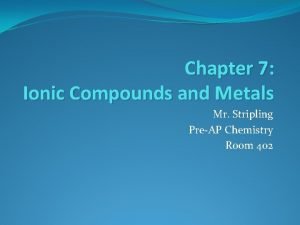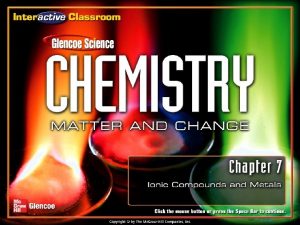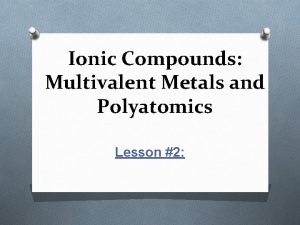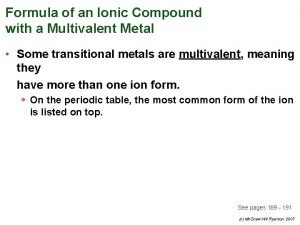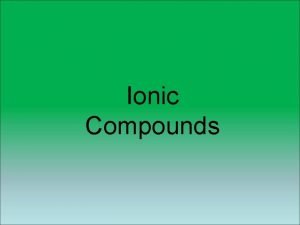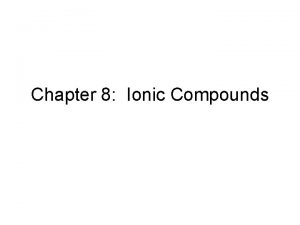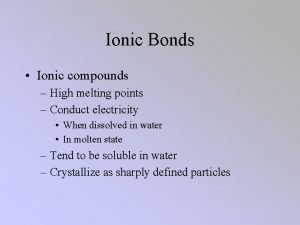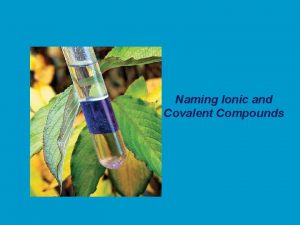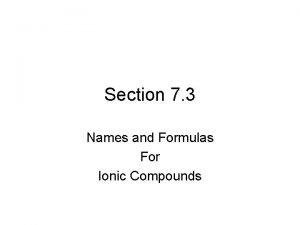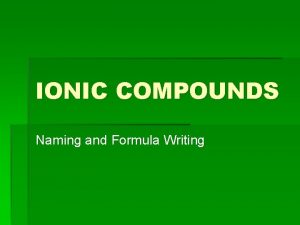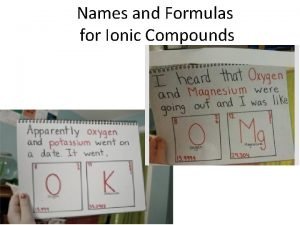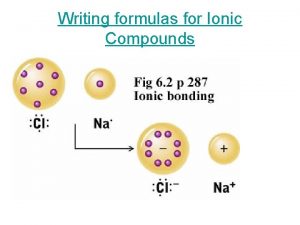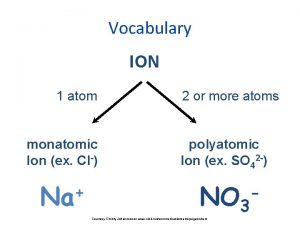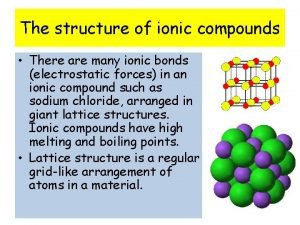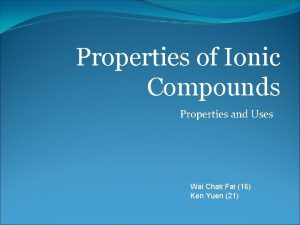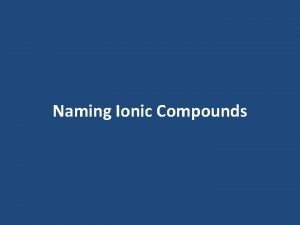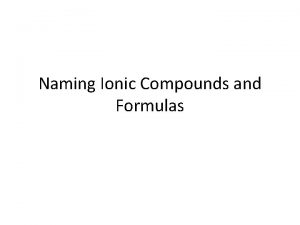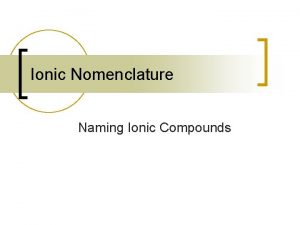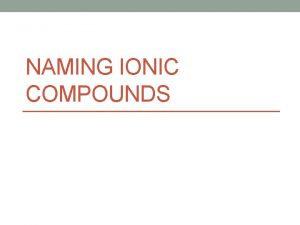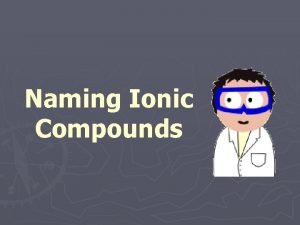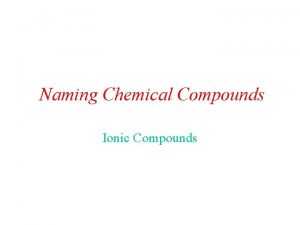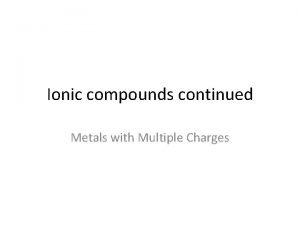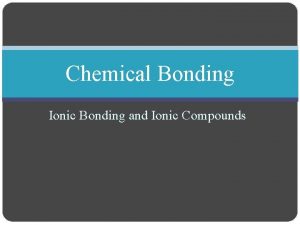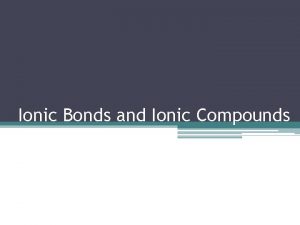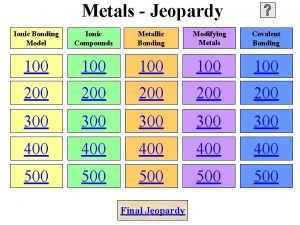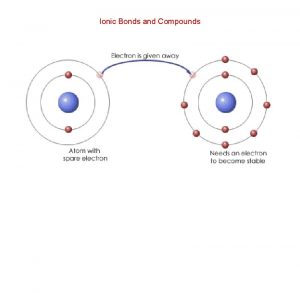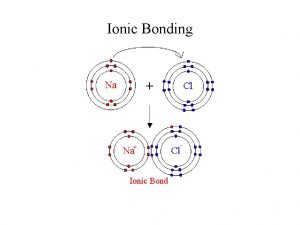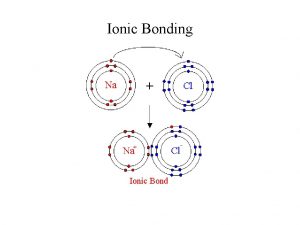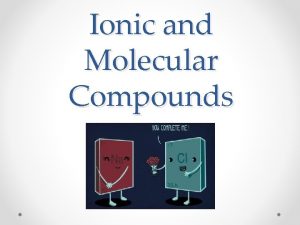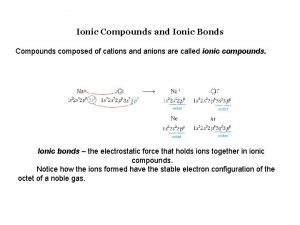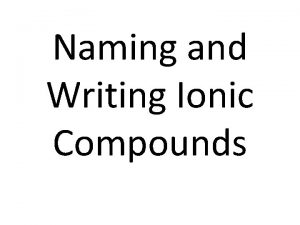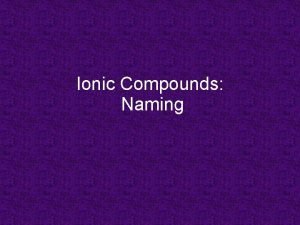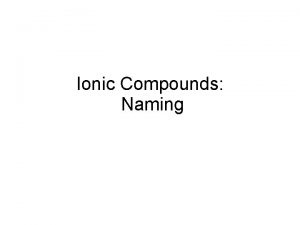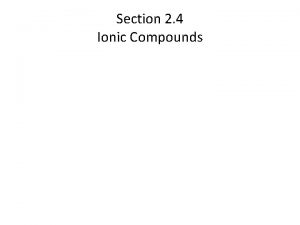Chapter 7 Ionic Compounds and Metals Mr Stripling














![Compound Formation & Charge �Ca: [Ar] 4 s 2 Needs to lose 2 electrons Compound Formation & Charge �Ca: [Ar] 4 s 2 Needs to lose 2 electrons](https://slidetodoc.com/presentation_image_h/158f52215b9bb2ddf4afb61859a22099/image-15.jpg)
















- Slides: 31

Chapter 7: Ionic Compounds and Metals Mr. Stripling Pre-AP Chemistry Room 402

Ion Formation �Valence electrons are involved in the formation of chemical bonds between two atoms. �Chemical Bond – force that holds two atoms together �Chemical bonds form by: 1. Attraction between the positive nucleus of one atom and the negative electrons of another atom 2. The attraction between positive ions and negative ions

Valence Electrons �Electron-dot structures are used to keep track of valence electrons �They are also useful in illustrating chemical bonds

Review � Ionization Energy – how easily an atom loses an electron �Electron Affinity – how much attraction an atom has for electrons �Reactivity depends on the number of valence electrons �Elements tend to react in order to acquire the stable electron configurations of noble gases

Positive Ion Formation �Occurs when an atom loses one or more valence electrons �Positively charged ions are called cations

�Ne: 1 s 22 p 6 �Na: 1 s 22 p 63 s 1 �When Na loses its valence electron its electron configuration becomes identical to Ne �Na gains a stable electron configuration �Na DOES NOT BECOME Ne �Na is a sodium ion with a single positive charge

Metal Ions �Reactive because they lose valence electrons easily �Groups 1 and 2 metals are the most reactive metals �Some group 13 atoms also form ions

Transition Metal Ions �Have an outer energy level of ns 2 �Form 2+ ions when forming positive ions �d electrons can also be lost, making it possible for transition metals to form ions of 3+ or greater �Difficult to predict the number of electrons that will be lost �Fe forms both Fe 2+ and Fe 3+ ions

Pseudo-Noble Gas Configurations �Electron configurations other that the noble gas notation can provide stability �Elements in groups 11 -14 lose electrons to form an outer energy level containing full s, p, and d sublevels

Negative Ion Formation �Nonmetals, on the right side of the table, easily gain electrons to attain a stable outer electron configuration �Gaining electrons forms anions, negatively charged ions �To designate an anion, the ending –ide is added to the root name of the element �Chlorine atom -> chloride anion

Nonmetal Ions �Nonmetals gain valence electrons in order to have a total of 8 �Some nonmetals can lose OR gain electrons to form an octet �Phosphorus can lose five or gain three valence electrons to form an octet �In general, group 15 -17 elements gain valence electrons to form an octet


Formation of an Ionic Bond �Ionic Bond – the electrostatic force that holds oppositely charged particles together in an ionic compound �Ionic compounds – compounds that contain ionic bonds. �Ionic bonds that occur between metals and oxygen form an oxide ion

Binary Ionic Compounds �Compounds that ONLY contain TWO different elements �Part metallic cation, part nonmetallic anion �Examples: �Sodium chloride (Na. Cl) �Magnesium oxide (Mg. O)
![Compound Formation Charge Ca Ar 4 s 2 Needs to lose 2 electrons Compound Formation & Charge �Ca: [Ar] 4 s 2 Needs to lose 2 electrons](https://slidetodoc.com/presentation_image_h/158f52215b9bb2ddf4afb61859a22099/image-15.jpg)
Compound Formation & Charge �Ca: [Ar] 4 s 2 Needs to lose 2 electrons to be stable �F: [He] 2 s 22 p 5 Must gain 1 electron for stability �Number of electrons lost and gained must be equal � 2 F atoms need to accept the 2 electrons from the Ca atom �Yields calcium fluoride (Ca. F 2)

�Aluminum oxide (Al 2 O 3) �Aluminum loses 3 electrons �Oxygen atoms gain 2 electrons � 3 oxygen atoms are needed to accept six electrons lost by 2 aluminum atoms

Properties of Ionic Compounds �Chemical bonds determine properties of compounds �Carpet, ceramics/glass, glossy paper, toothpaste �Strong attraction among positive and negative ions in an ionic compound forms a crystal lattice �Crystal lattice �a three-dimensional geometric arrangement of particles �Each positive ion is surrounded by negative ions and each negative ion is surrounded by positive ions

Physical Properties �MP, BP, and hardness are physical properties that depend on how strong particles that make compounds are attracted to one another �Electrical conduction depends on availability of free moving charged particles �Ionic solids don’t conduct electricity �Ionic liquids do �An ionic compound whose aqueous solution conducts an electric current is an electrolyte

�Ionic bonds are relatively strong �Ionic crystals require a large amount of energy to be broken �Ionic crystals have high melting and boiling points

Energy and the Ionic Bond �Every chemical reaction absorbs or releases energy �Endothermic reaction – energy is absorbed �Exothermic reaction – energy is released �Ionic compound formation is always exothermic

Lattice Energy �Energy required to separate 1 mole of ions of an ionic compound �Strength of the forces holding ions in place �Directly related to the size of the ions bonded

Classwork �Problems 7 -11 on page 212 �Problems 1 & 2 (Chapter 7) on page 980 �Only write the formula units

Formulas for Ionic Compounds �Formula Unit – the chemical formula for an ionic compound represent the simplest ratio of the ions involved �Mg. Cl 2 – magnesium and chloride ions exist in a 1: 2 ratio �Contains one Mg 2+ ion and two Cl- ions for a total charge of zero �Mg 2+ and Cl- are monatomic ions – one-atom ions

Oxidation Numbers �Charge of a monatomic ion equals its oxidation number or oxidation state �Equals the number of electrons transferred from the atom for an ion �Example: �Sodium atom transfers one electron to a chlorine atom to form sodium chloride �Na+ and Cl�Sodium oxidation number = 1+ �Chlorine oxidation number = 1 -

Formulas for Binary Ionic Compounds �Symbols for cation is always written first, followed by the symbol of the anion �Subscripts �Small numbers to the lower right of a symbol �Represent the number of ions of each element in an ionic compound �If there is no subscript, assumed to be 1 �Oxidation numbers are used to write formulas for ionic compounds

Formulas for Polyatomic Ionic Compounds �Polyatomic ion – ions made up of more than one atom �Act as individual ions �Charge applies to the entire group of atoms �Act as a unit, so the change the subscripts of the atoms within ions �Ammonium ion (NH 4+) and oxide ion (O 2 -) � (NH 4)2 O

Naming an Oxyanion �Oxyanion – a polyatomic ion composed of an element (usually nonmetal) bonded to one or more oxygen atoms

Oxyanion Naming Conventions for Sulfur and Nitrogen �Identify the ion with the greatest number of oxygen atoms. This ion is named using the root of the nonmetal and the suffix –ate �Identify the ion with fewer oxygen atoms. This ion is named using the root of the nonmetal and the suffix -ite �Examples: �NO 3 nitrate NO 2 - nitrite �SO 42 sulfate SO 32 - sulfite

Oxyanion Naming Convention for Chlorine �The oxyanion with the greatest number of oxygen atoms is named using the prefix per-, the root of the nonmetal and the suffix –ate �The oxyanion with one fewer oxygen atom is named using the root of the nonmetal and the suffix –ate �The oxyanion with two fewer oxygen atoms is named using the root of the nonmetal and the suffix –ite �The oxyanion with three fewer oxygen atoms is named using the prefix hypo-, the root of the nonmetal, and the suffix -ite

Classwork �Problems 19 -22 on page 221 �Problems 24 -26 on page 222 �Problems 28 -32 on page 223

Read Page 226
 Ionic compounds
Ionic compounds 7 ionic and metallic bonding practice problems
7 ionic and metallic bonding practice problems Ionic compounds and metals chapter 7
Ionic compounds and metals chapter 7 Chapter 7 ionic compounds and metals assessment answer key
Chapter 7 ionic compounds and metals assessment answer key Robert stadnicki
Robert stadnicki Ionic vs covalent bonding venn diagram
Ionic vs covalent bonding venn diagram Ionic compounds with multivalent metals
Ionic compounds with multivalent metals Multivalent ionic compounds
Multivalent ionic compounds Ionic compounds containing transition metals
Ionic compounds containing transition metals Non metals examples
Non metals examples When a metal reacts with a nonmetal the metal will
When a metal reacts with a nonmetal the metal will Metals on periodic table of elements
Metals on periodic table of elements Characteristics of metals
Characteristics of metals Physical properties of materials grade 7
Physical properties of materials grade 7 Social science grade 7 term 2
Social science grade 7 term 2 Non metal example
Non metal example Monotomic ion
Monotomic ion Ferrous vs non ferrous
Ferrous vs non ferrous Monatomic ion definition chemistry
Monatomic ion definition chemistry Ionic bond melting point
Ionic bond melting point Covalent compound hi
Covalent compound hi Section 3 names and formulas for ionic compounds
Section 3 names and formulas for ionic compounds Di vs bis
Di vs bis Section 3 names and formulas for ionic compounds
Section 3 names and formulas for ionic compounds Criss-cross method steps
Criss-cross method steps Ternary ionic compounds
Ternary ionic compounds Ternary ionic compounds
Ternary ionic compounds Melting point sodium chloride
Melting point sodium chloride Solubility vs solubility product
Solubility vs solubility product Uses of ionic compounds
Uses of ionic compounds P2o5 compound name
P2o5 compound name How do you name an ionic compound
How do you name an ionic compound


